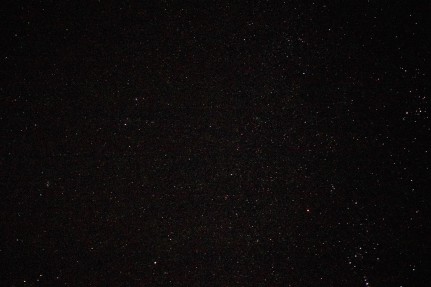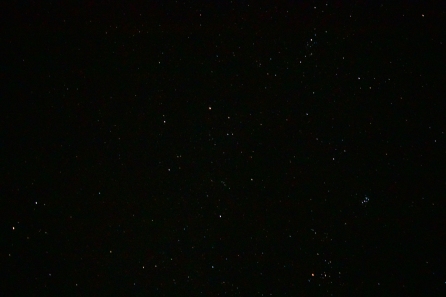![DSC_1235[1] orion wide view.JPG](https://vamoswearegolden.files.wordpress.com/2017/01/dsc_12351-orion-wide-view.jpg?w=446&h=297)
December night sky featuring Orion and Sirius (lower centre)- the brightest star in the night sky (photo credit- A. Rossiter)

Close-up of the Milky Way with Orion in the lower right corner (Photo Credit- A. Rossiter)
However, I soon got too distracted by the stunning night sky landscape to notice how scared (or cold) I was. I am rather proud of the fact that I have a rather good view of the night sky from my own bark garden, which is rare for anyone living in a sub-urban area, so good sometimes that even the milky way is visible. However, that was nothing compared to what I saw that night. As soon as I stepped shivering out of the car, the milky way lit up the night sky; a clear ribbon of white and blue stars stretched from the horizon, upwards over my head and then back down to the opposite horizon. If that wasn’t awesome enough, Orion the constellation of the hunter was in prime position in the South-East. Orion has always been my favourite constellation as it was the first thing I ever observed whilst stargazing; it was thanks to this constellation that I got into astronomy. However, Orion is special because it has examples of so many astronomical objects such as, Betelgeuse, a large red super giant star about to explode into a supernova before it dies; young stars still within the nebula that created them; several examples of nebulae from the Orion nebula to the Flame nebula and the Horse-head nebula, not to mention the cluster of galaxies too faint to see unless viewed through something like the Hubble Space Telescope. Orion even has its own meteor shower during another time of the year. I always love the story about Orion and Scorpius (another constellation best seen in the late summer) in Greek Mythology. If you are observant then you will notice that Orion and Scorpius are never in the sky at the same time as each other. According to the myth- Orion and Scorpius were fierce foes constantly fighting. The Gods got so fed up with their constant bickering that they put Orion in one part of the sky and Scorpius in the other, so that the two could never meet. I guess that is bit like putting two arguing children in opposite corners of the room as punishment!

Taurus and the Pelaides star cluster are visible in the lower right of this image (photo credit: A. Rossiter)
Orion wasn’t the only wonder though: I focused my binoculars on the Pleiades star cluster in the constellation of Taurus, the bull. Pleiades, otherwise known as the seven sisters, is a very bight open star cluster that is bright enough to be seen well from urban areas. As the name suggests, it contains seven bright stars visible to the naked eye, although it is hard to see seven, but if you see six then you can be proud of yourself! Up close hundreds become visible, I once observed the Pleiades through my telescope and estimated around 250-300 stars. The Ancient Romans used the Pleiades as a way of testing the eye sight of soldiers about to join the Roman army.

Andromeda Galaxy (Photo credit: EarthSky)
Before we left I also had a look at the Andromeda galaxy through my binoculars. This is extra special as everything I mentioned before is located within the Milky Way galaxy, but Andromeda is an intergalactic object since it’s outside of the Milky Way. It is a galaxy of similar type to the Milky Way, but is twice the size and is actually moving towards us so one day the Andromeda galaxy will crash into the Milky Way galaxy- though this is a very gradual process so don’t panic (I don’t want to be responsible for another one of those end of the word news stories). The Andromeda galaxy is 2.5 million light years from Earth- this means that it takes 2.5 million years for light from the Andromeda galaxy to reach my eyes whilst I am looking at it. Therefore, I was seeing the Andromeda galaxy as it appeared 2.5 million years ago, which was about the same time at humans were emerging from Africa. If anyone needs proof of how big the universe is then I think that is it!
I would have carried on all night looking at the sky, but there is only so much cold my hands and feet could take. But if you are ever in need of something to do on a clear winter evening, go outside and look up and have a think about how much is out there and who or what may be looking back at you.

Wow you are so lucky you can see the stars from your back garden at night – living in London means that we can barely ever see the stars!